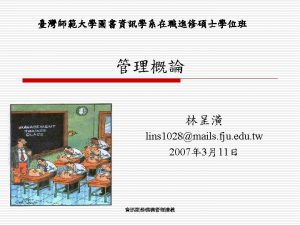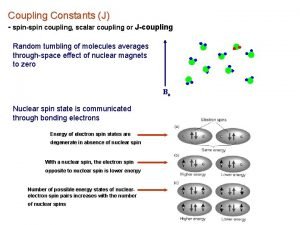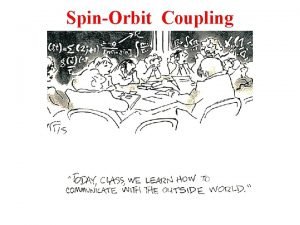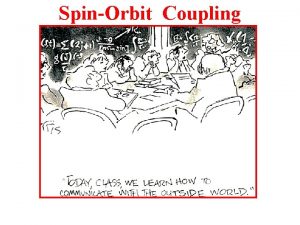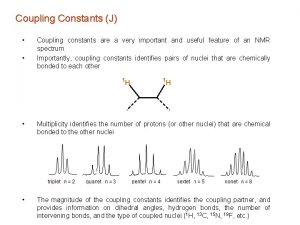Coupling Not what first comes to mind Copyright














- Slides: 14

Coupling Not what first comes to mind Copyright © 2014 by Curt Hill

Coupling • Coupling, in Computer Science and Software Engineering, describes the dependency of one thing upon another – The things in question are usually functions and objects – May also refer to interdependency • Low coupling means an item is not very dependent on another • High coupling means that we cannot use the one without the other Copyright © 2014 by Curt Hill

Terminology • Low coupling is sometimes referred to as weak or loose – Generally desirable for functions and objects – Indicates well designed modules • High coupling – AKA tight or strong – Inhibits reuse in other programs Copyright © 2014 by Curt Hill

Informal Example • The coupling of a customer and clerk in a store is low – Communicate through common language – Either person is interchangeable with another • Family relationships are usually high – Parents/siblings/spouse are tightly coupled – No interchangeability Copyright © 2014 by Curt Hill

Types of Coupling 1 • Content (high) – A module relies on the internal workings of another • Common (high to medium high) – Two modules use common global variables – Changing the globals requires a change in the modules • External (medium) – Two modules share a common data format or protocol Copyright © 2014 by Curt Hill

Types of Coupling 2 • Control (medium) – One module controls the execution of another – Often a parameter that alters the type of processing • Stamp or data structure – Two modules use a common data structure, but not the same portions of it – Changing the data structure may mandate changes in one without the other Copyright © 2014 by Curt Hill

Types of Coupling 3 • Data (low) – Data is shared, but the data is simple, such as in parameters – Often a parameter that alters the type of processing • None – Two modules share nothing Copyright © 2014 by Curt Hill

Coupling Issues • Highly coupled systems become harder to maintain • A change in one module forces changes in others • A ripple effect occurs as change ripples through the system Copyright © 2014 by Curt Hill

Some Examples • GUI programs are typically Common coupled – Event handlers rely on the fact that certain edit boxes or labels are available – Cutting the event handler out of one program and putting it into another is never done • Math library functions – Those programs that use them are Data coupled to them – They are not coupled to each other Copyright © 2014 by Curt Hill

The Date class example • The methods are stamp or common coupled with one another – get. Day is stamp coupled with get. Month – To. String is common coupled with get. Day – Changing the form of the month, day and year mandates changes in every method • Since the class is a unit this is not a problem Copyright © 2014 by Curt Hill

Date again • Suppose that the correct function were missing and not called • Then the date class would be dependent on its client to supply good data • This would shift the checking to the client • This would increase the coupling between the client and the class Copyright © 2014 by Curt Hill

High Coupling is Not Evil • Very often we have a program that has a central data structure or many data structures • Nearly every method/function uses one or more of these • We do not need to pass every data structure to every function – Just use it as global data – This is not bad but it prevents reuse of the function Copyright © 2014 by Curt Hill

The Other Coupling • Multiple CPU systems also use this term • Two CPUs that have a common memory is termed tightly coupled • Two CPUs that are connected by some other type of high speed communications is loosely coupled • Current multicore CPUs are tightly coupled, while the CPU to GPU coupling is loose Copyright © 2014 by Curt Hill

Conclusion • When designing classes we generally want the lowest possible coupling – This allows us to reuse the class – This allows us to rewrite the class without breaking other things • Many programs have one-shot classes – They are designed for this particular application – Little chance of reusability Copyright © 2014 by Curt Hill
 First comes love then comes marriage
First comes love then comes marriage What comes to your mind
What comes to your mind What comes to your mind when you see this symbol
What comes to your mind when you see this symbol What comes to your mind when you hear the evidence
What comes to your mind when you hear the evidence When you hear the word bank
When you hear the word bank What comes to mind when you hear the word 'family'?
What comes to mind when you hear the word 'family'? What comes to your mind when you think about god
What comes to your mind when you think about god What do you think of when you hear the word science
What do you think of when you hear the word science What comes to your mind
What comes to your mind Aw tozer what comes to mind
Aw tozer what comes to mind What comes into your mind
What comes into your mind Sadlier level d unit 1 synonyms
Sadlier level d unit 1 synonyms Mindmaster windows
Mindmaster windows A wandering mind is an unhappy mind
A wandering mind is an unhappy mind The critical mind is a questioning mind
The critical mind is a questioning mind








